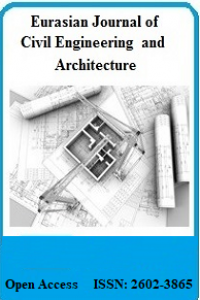EXAMINING THE COMPONENTS OF GREEN BUILDING DESIGN AND ITS MANAGEMENT SYSTEM
EXAMINING THE COMPONENTS OF GREEN BUILDING DESIGN AND ITS MANAGEMENT SYSTEM
Green Building, Environment Management System, Energy,
___
- A Guid to the Project Management Body of Knowledge, (PMBOK® Guide)—Fifth Edition, Project Management Institute. Pennsylvania, USA, 2004.
- Bahaudin, A.Y. Eliasm E.M. Saifudin, A.M. A Comparison of the Green Building’s Criteria, E3S Web of Conferences, EDP Sciences, 2014; 01015: 1-10.
- Gajewska, L. Ropel, M. Risk Management Practices in a Construction Project - a case study, Chalmers University of Technology, Goteborg, Sweden, 2011
- Lindholm, G. <
> as Activity and as Object- Implications for Urban Planning. NA, 2015. - Manson., M. Green wall System: A Review of Their Characteristics. Renewable and Sustainable Energy Reviews, 2015; 41: 863-871.
- Moharil., R.M. Kulkarni., P.S. A Case Study of Solar Photovoltaic Power System at Sagardeep Island, India, Renewable and Sustainable Energy Reviews. 2009; 13: 673 -681.
- Perez., G. Rincon., L. Vila., A. Gonzalez., J.M. Cabeza., L. F. “Green vertical systems for buildings as passive systems for energy savings. Applied Energy, 2011; 88(12): 4854-4859.
- Smith,. N.J. Merna., T. Jobling.,P. Managing Risk in Construction Projects, John Wiley & Sons, New York, USA, 2009.
- Tan,. Y. Shen ,. L. hong., Y. Sustainable Construction and Contractors Competitiveness ; a preliminary Study. Habitat International, 2011; 35: 225-230.
- Thompson., W. Sorvig., K. Sustainable Landscape Construction: A Guide to Green Building Outdoors. Second Edition. Island Press. USA, 2007.
- Wanga., J. Yuanb., H. Kangc., x. Lud., W. Critical success factors for on-site sorting of construction waste: a China study. Resources, conversation and Recycling, 2010; 54(11): 931-936.
- Webb., A. The Project Manager’s Guide to Handling Risk, The Project Manager’s guide to Handling Risk, gower publishing Ltd. Aldershot, United Kingdom, 2003.
- Winch., G.M. Managing Construction Projects Second Edition, John Wiley & Sons, New York, USA, 2009.
- Yellamraju., V. LEED-New Construction Project Management, McGraw Hill, New York, USA, 2011.
- Başlangıç: 2017
- Yayıncı: Serkan ŞAHİNKAYA
EXAMINING THE COMPONENTS OF GREEN BUILDING DESIGN AND ITS MANAGEMENT SYSTEM
Mohammad BEYKZADE, Sepide BEYKZADE
ANALYSIS OF THE WATER USE IN DIFFERENT TYPES OF BUILDINGS
EFFECT OF LIME ON UNCONFINED COMPRESSIVE STRENGTH OF A LOW PLASTICITY CLAYEY SOIL
Mustafa KARASAHİN, Erdinç KESKİN, İlker ŞAHİNOĞLU
Ayşe EDİNÇLİLER, Yasin Sait TOKSOY
SURFACE FLOW, URBAN AND LAND-BASED POLLUTION LOADS IN DAVUTLAR BAY
INVESTIGATION OF FLUID-STRUCTURE INTERACTION BY USING SOLIDITY RATIO
